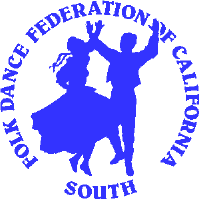
|
Folk Dance Federation of California, South, Inc.
By Dick Oakes |
THIS IS HISTORICAL INFORMATION ONLY
CLICK AN IMAGE TO ENLARGE
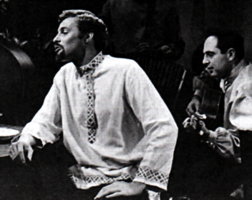 Westwind International Folk Ensemble began in the summer of 1959 when UCLA instructor and well-known folk singer and ethnomusicologist Michael "Mike" Janusz organized "The Los Angeles International Folk Chorus." At first, the chorus began practicing at the Ash Grove and later found a more spacious location at the Westside Jewish Community Center where they had given their first performance earlier in December of 1959.
Westwind International Folk Ensemble began in the summer of 1959 when UCLA instructor and well-known folk singer and ethnomusicologist Michael "Mike" Janusz organized "The Los Angeles International Folk Chorus." At first, the chorus began practicing at the Ash Grove and later found a more spacious location at the Westside Jewish Community Center where they had given their first performance earlier in December of 1959.
The ensemble's first full concert was a part of the second annual UCLA Folk Festival in the summer of 1960 at UCLA's Royce Hall to raise money for the International Students' Center Building. As a result of this initial contact with the wider folk dance community, chorus members found many dancers interested in the new group.
In 1961 dancers joined the ensemble, with Vince and Robin Evanchuk organizing the dance material. An orchestra soon followed, ultimately directed by the talented Victor Pierce. Though costumes had not yet been introduced, at the beginning of 1961 folk singers, folk dancers, and folk musicians developed into a solid group under the direction of Artistic Director Mike Janusz with aid from Robin and Vince Evanchuk in the Dance Section, and later Victor Pierce as Orchestra Director with Mike's wife Leslye Janusz as Registrar of the group. The first two suites were from Russia and the United States, both of which integrated music, song, and dance.
In 1961, at the home of Ron Segal, the name Westwind was brought up. Mike said it was prevailing wind and in California often called the "Santana," the "Santa Ana," the "Devil Wind," and the "Big Wind." Perfect! The first performance as Westwind International Folk Ensemble was presented in 1961, and the group quickly grew to include more than fifty members.
As "Westwind," the first performance was in various sections of the UCLA Folk Festival on March 28th and 29th of 1961. There were performances in the Santa Monica and Pasadena Co-op folk dance groups as well as presentations at folk festivals for Los Angeles City College and at Ojai. The group also performed at the Banjo and Fiddle Contest, the Valley-Cities Jewish Community Center, and at an A.A.U.N. fuction at Steve Allen's home. On October 10, 1962, the first issue of "The Windjammer," the official publication of the group, was distributed to its members after rehearsal. The Windjammer staff consisted of Neal Sandler, Carol Sandler, Katie Sanders, Leslye Janusz, David Pierce, and Pearl Rottenberg.
In September of 1962, Robin Evanchuk and Ruth Garber embarked on a fieldwork trip to New York, conducting primary research for the Shaker Worship Service. The clothing and patterns Ruth made were outstanding and the music and movement began for Robin a detailed investigation that has lasted for most of her life.
At the same time the Shaker fieldwork was progressing, Vince Evanchuk and Don Green were on their own field trip to the Ukraine, Moldavia, and Georgia. At that time, these countries were still part of the USSR and they were not allowed to simply wander to any area they wished. Nevertheless, they thoroughly enjoyed their stay and acquired dance notes, music, costumes, books, photos, miscellaneous folklore information, and lots and lots of wonderful wines.
On October 14 of 1962, the company presented Emil Cossetto's "Ladarke." The choreographer of the suite was Elsie Dunin. December of 1962 also was a busy month. On December 2nd, the dances "Kosmet" and "Rugovo" were performed at the Santa Monica Civic Auditorium during the Long Beach Folk Festival. On the 15th, Westwind joined the Los ANgeles Mandolin Orchestra Concert with "Sea Chanties," part of Vince's "Ukrainian Wedding" which was still being worked on. Mike directed "Shape Note Hymns" and the "East Texas Knockdown" staged by Robin. Finally, on the 23rd of December, the chorus did the KPFK Christmas Radio Show, singing Christmas carols from all over the world.
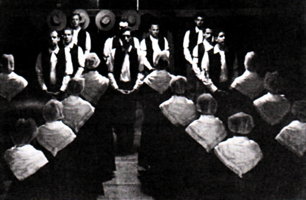 In this first phase of the ensemble, the staging included an East Texas knockdown and Shape-note hymns, the representation of the old Shaker Service, Emil Cossetto's beloved Ladarke suite, a Ukrainian Wedding Suite (Ternopil'ska Vesily), 'Tatarotchka', a dance for trios from the Crimea, and Russian songs. The orchestra was increasingly sought after to play folk music of over 30 nationalities at folk festivals, folk dance parties, and private functions of many sorts.
In this first phase of the ensemble, the staging included an East Texas knockdown and Shape-note hymns, the representation of the old Shaker Service, Emil Cossetto's beloved Ladarke suite, a Ukrainian Wedding Suite (Ternopil'ska Vesily), 'Tatarotchka', a dance for trios from the Crimea, and Russian songs. The orchestra was increasingly sought after to play folk music of over 30 nationalities at folk festivals, folk dance parties, and private functions of many sorts.
From November of 1962 to the middle of 1963, Westwind had increased its membership from 46 to 63 with 12 new associate members or part-time performers. Because they needed more space, they moved rehearsals to Temple Sharei Teflia. Another excellent performance was done at Hollywood High School. Two or three times each month, the company performed for such venues as the Monterrey Folk Song Festival, the Kolo Festival, and another A.A.U.N. show at the home of Gordon McRae. The company also did a concert for the American Association for Afro-American Relations toward the end of 1963. The company won an Isadora Duncan award for Robin's carefully updated Shaker performance.
New repertoire was constantly being added (as were rehearsal nights), with such dances as the Ukrainian "Horovod," Children's Play Parties, Georgian Dances, and the "Russian City Quadrilles." Singers were in rehearsal for new Shape Note Hymns, Georgian Songs, and traditional songs of numerous countries and seasons of the year. Directors were meeting at least one night a week. The musicians were working on their own instrumental presentations as well as accompanying the dances and songs. Even more staff was needed -- and added. Jennifer Thomas was now Director of Public Relations, Marsha Shore and Mallory Pearce became the Technical Supervisors of the directorial staff that managed lighting, sound, and costume production. As of the first of April of 1964, payment of membership dues was discontined. Honorary Sponsors were Bess Lomas Hawes, Sam Hinton, Councilman Billy G. Mills, State Senator thomas Rees, Dr. Alma Hawkins, Dr. Annaliese Laundau, Edwin M. Pearl, Herschel Bernardi, and Marxha Hunt-Presnal.
At one special Director's meeting, Mike announced that he was ready to move on. So were Victor and Vince, and Leslye had lots to do, including directing "Nashi Dyevushki" (her singing group). Robin announced that her intentions to were to return to UCLA to get a degree in Folklore.
Thus, Neal Sandler and Anthony Ivancich became Directors in 1964. Like new experiments, Westwind had no guidelines on how to function and the ensemble became very unstable. The company was divided and much of the personel was siphoned off into other groups. Westwind continued, but without the creative drive that it had once contained. A Croatian suite was added as well as some Spanish dances and Moiseyev's Russian City Quadrilles. Many of the problems then encountered have been solved by other groups and certainly, all of the members of Westwind gained some insight into group dynamics.
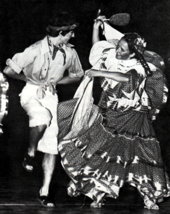 In 1965, some of the members moved to the San Francisco Bay area. Permission was granted to use some of the material and form a northern branch of Westwind.
In 1965, some of the members moved to the San Francisco Bay area. Permission was granted to use some of the material and form a northern branch of Westwind.
In 1966, the Ensemble split into its Northern and Southern counterparts with Neal's move to the Bay Area. There now existed two companies in two different cities, 400 miles apart. The Los Angeles group retired from performing, leaving only the San Fancisco company active.
In 1968, a new Los Angeles Westwind was begun. It was restructured and its emphasis as to the how and of what material it would perform was changed. It would pride itself on creating new works rather than copying that material that other professional, national, and international classical companies and ensembles performed.
Over the next decade, many classic suites came into being: an English suite on the Green, an Extramduran Wedding, Spanish Aragonesa dances, a Quadrille Suite from the United States, and others.
Los Angeles Westwind's main thrust became the enlargement of the Westwind Ensemble and the increasing of its potential exposure to other audiences.
After moving with his family to Hanford, California in 1978, Mike became ill with a rare pre-senile dementia called "Pic's Disease." He passed away on July 18, 1981, survived by his wife Leslye, and daughters Daniella and Halina.

1976 |

1980 |
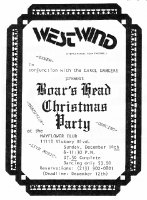
1980 |
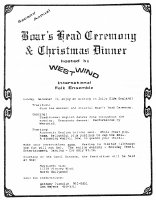
1981 |

1982 |
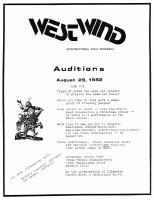
1982 |
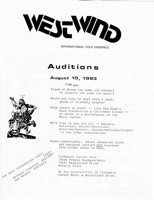
1983 |
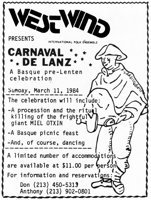
1983 |
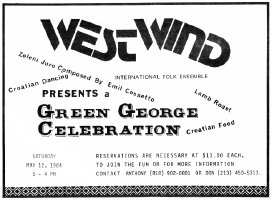
1984 |

1985 |
